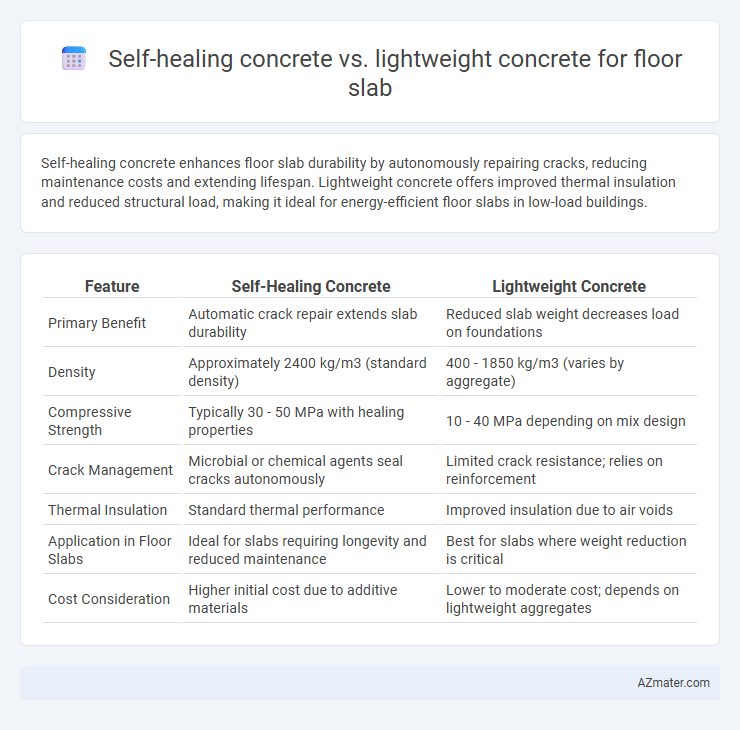Self-healing concrete enhances floor slab durability by autonomously repairing cracks, reducing maintenance costs and extending lifespan. Lightweight concrete offers improved thermal insulation and reduced structural load, making it ideal for energy-efficient floor slabs in low-load buildings.
Table of Comparison
| Feature | Self-Healing Concrete | Lightweight Concrete |
|---|---|---|
| Primary Benefit | Automatic crack repair extends slab durability | Reduced slab weight decreases load on foundations |
| Density | Approximately 2400 kg/m3 (standard density) | 400 - 1850 kg/m3 (varies by aggregate) |
| Compressive Strength | Typically 30 - 50 MPa with healing properties | 10 - 40 MPa depending on mix design |
| Crack Management | Microbial or chemical agents seal cracks autonomously | Limited crack resistance; relies on reinforcement |
| Thermal Insulation | Standard thermal performance | Improved insulation due to air voids |
| Application in Floor Slabs | Ideal for slabs requiring longevity and reduced maintenance | Best for slabs where weight reduction is critical |
| Cost Consideration | Higher initial cost due to additive materials | Lower to moderate cost; depends on lightweight aggregates |
Introduction to Modern Concrete Innovations
Self-healing concrete incorporates microcapsules or bacteria to autonomously repair cracks, enhancing durability and reducing maintenance costs in floor slabs. Lightweight concrete, made by adding lightweight aggregates such as expanded clay or shale, offers improved thermal insulation and reduces structural load without compromising strength. Both innovations significantly contribute to sustainable construction by optimizing performance and extending the lifespan of floor slab applications.
Understanding Self-Healing Concrete: Features and Mechanisms
Self-healing concrete incorporates microcapsules or bacteria that activate to repair cracks autonomously, enhancing durability and reducing maintenance costs in floor slabs. Its ability to seal microcracks prevents water ingress and corrosion of reinforcement, thereby extending structural lifespan compared to traditional lightweight concrete. Lightweight concrete, while offering reduced weight and thermal insulation, lacks intrinsic crack-repair mechanisms present in self-healing variants.
Overview of Lightweight Concrete: Composition and Benefits
Lightweight concrete is composed of cement, water, fine and coarse aggregates such as expanded clay, shale, or pumice, which reduce its density compared to conventional concrete. Its reduced weight leads to lower structural loads, improved thermal insulation, and easier handling, making it ideal for floor slabs in buildings seeking enhanced energy efficiency. The material also offers increased fire resistance and better sound insulation, contributing to overall building performance and longevity.
Floor Slab Performance Requirements: Key Considerations
Self-healing concrete enhances floor slab durability by autonomously repairing micro-cracks, reducing maintenance costs and extending service life, crucial for high-traffic areas requiring long-term resilience. Lightweight concrete offers significant benefits through reduced slab weight, improving load distribution and minimizing structural demands, ideal for buildings prioritizing seismic resistance and ease of installation. Selecting between self-healing and lightweight concrete depends on performance requirements such as crack resistance, structural load capacity, thermal insulation, and lifecycle sustainability for floor slab applications.
Strength and Durability Comparison: Self-Healing vs Lightweight Concrete
Self-healing concrete exhibits superior durability due to its ability to autonomously repair micro-cracks, reducing maintenance needs and extending the lifespan of floor slabs. Lightweight concrete, while beneficial for reducing structural load, generally has lower compressive strength and increased susceptibility to shrinkage and cracking compared to self-healing concrete. Consequently, self-healing concrete offers enhanced long-term strength retention and resilience in floor slab applications.
Crack Resistance and Maintenance Needs
Self-healing concrete offers superior crack resistance for floor slabs by autonomously repairing micro-cracks through embedded healing agents, significantly reducing maintenance needs and extending the lifespan of the structure. Lightweight concrete, although beneficial for reducing load and improving thermal insulation, generally exhibits lower crack resistance and requires more frequent maintenance to address shrinkage and surface cracking. When prioritizing crack resistance and minimal maintenance, self-healing concrete presents a more durable and cost-effective solution compared to lightweight concrete in floor slab applications.
Structural Load and Weight Implications
Self-healing concrete enhances structural load capacity by autonomously repairing microcracks, reducing maintenance and extending floor slab durability under heavy loads. Lightweight concrete significantly lowers slab weight, decreasing overall structural load and foundation stress, making it ideal for applications requiring reduced dead load. Balancing self-healing capabilities with the reduced weight benefits of lightweight concrete optimizes floor slab performance for both strength and longevity.
Longevity and Lifecycle Cost Analysis
Self-healing concrete significantly enhances longevity in floor slabs by autonomously repairing microcracks, reducing maintenance frequency and associated costs over the lifecycle. Lightweight concrete offers benefits in thermal insulation and ease of installation but may exhibit lower durability under high stress, potentially increasing long-term repair expenses. Lifecycle cost analysis favors self-healing concrete when factoring in extended service life and reduced downtime, despite its higher initial material cost compared to lightweight concrete.
Sustainability and Environmental Impact
Self-healing concrete significantly reduces maintenance costs and extends the lifespan of floor slabs by autonomously repairing micro-cracks, thereby minimizing the environmental impact associated with frequent repairs and replacements. Lightweight concrete decreases the structural load, which lowers material consumption and energy use during construction, contributing to sustainability by improving thermal insulation and reducing carbon emissions. Both materials enhance sustainability in floor slabs; however, self-healing concrete primarily addresses durability and waste reduction, while lightweight concrete focuses on energy efficiency and resource conservation.
Choosing the Optimal Concrete for Floor Slabs
Self-healing concrete offers enhanced durability by autonomously repairing microcracks, reducing maintenance costs and extending the lifespan of floor slabs in high-stress environments. Lightweight concrete provides superior thermal insulation and reduces dead load, making it ideal for structures requiring efficient load management and energy savings. Selecting the optimal concrete for floor slabs depends on balancing structural performance, maintenance requirements, and environmental conditions specific to the project.

Infographic: Self-healing concrete vs Lightweight concrete for Floor slab
 azmater.com
azmater.com